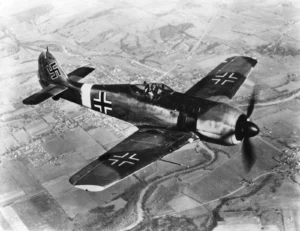German Air Forces on D-Day
Interventions by the Luftwaffe on June 6th 1944
![]()
![]() The squadrons deployed in Normandy on June 6, 1944
The squadrons deployed in Normandy on June 6, 1944
On 6 June 1944, the I/JG 2, I/JG 26, III/JG 26 and Stab squadrons were the only German Air Forces present on the spot.
The I/JG 2 Richthofen squadron took off its 19 FW 190 aircraft towards the Normandy coast, armed for the occasion with rocket launchers. Lieutenant Fischer of the III/JG2 claimed a successful shot on a Victory class allied vessel.
I/SKG 10 was engaged on the night of June 5 to 6, 1944 and the flasher chart displays four destroyed Lancaster bombers. The SKG 10 squadron claimed its first Lancaster at 05:01 on June 6 in the area of Isigny-sur-Mer.
IV/JG 3 squadron took off all of its aircraft in Normandy. These units were specialized in the fight against Allied bombers.
Three Henkel 177 from the KG 30 squadron took off from Bordeaux, France, for a night bombing mission (the objective being the beachhead) but all three aircraft were shot down by allied Mosquito (operating for the benefit of the air fighters) before the start of their operation.
For the day of June 6th, the claims of SKG 10 and JG 2 squadrons come to an end around 9pm reaching 23 claims. The reinforcements would arrive in number the following days: 200 additional fighters in the 36 hours following the D-Day and 100 others before the 10th of June.
![]() The most publicized intervention
The most publicized intervention
An intervention by two German planes was particularly mediated by Cornelius Ryan’s book “The Longest Day”, led by Geschwaderkommodore Joseph Priller of the JG 26 squadron. Priller and his winger, Heinz Wodarczyk, were the only ones in the JG 26 to strafe the Allied beaches during the landing operations, namely Sword and Juno Beach. They were the first to be in contact with the landed troops. The other aircraft of the squadron, based in the north of France, were on mission in Germany against Allied bombing. The two Luftwaffe pilots were convinced that they would not come back, but they returned base safe and sound.
At the time of their passage, there was no anti-aircraft artillery already landed and ready to fire. Their passage was at low altitude and they were not worried by the Allied fighters which flew at a higher altitude.

